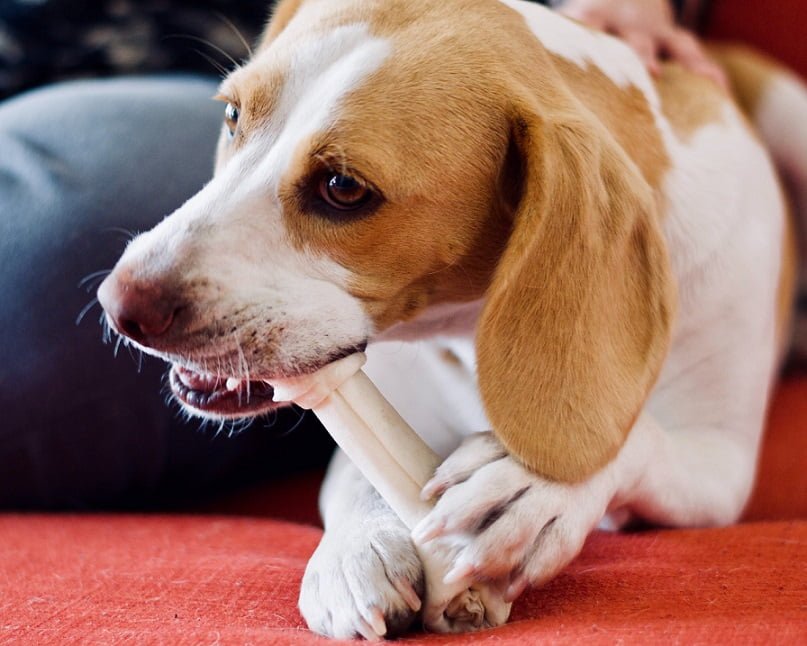If you’ve ever owned a dog, you’ve likely observed their seemingly insatiable desire to chew on bones. Whether a raw bone from the butcher or a specially designed chew toy, gnawing brings immense joy to our canine companions. But why do dogs have this natural inclination to chew on bones? Unraveling the roots of this behavior reveals fascinating insights into their evolutionary past and intrinsic instincts. We can better understand and cater to their needs by delving into their love for bones, ensuring their overall well-being and happiness.
Evolutionary Roots: Unveiling Ancestral Traits
To understand why dogs enjoy chewing on bones, we must turn our gaze back to their wild ancestors. As descendants of wolves, dogs share a common evolutionary history with these wild predators. In the wild, wolves hunted and consumed prey, including the bones. Chewing on bones provided them numerous benefits, such as extracting valuable nutrients, cleaning their teeth, and exercising their powerful jaw muscles. These instincts and behaviors have been passed down through generations, influencing the modern domesticated dogs we know today.
Instinctual Need for Chewing: Biological Reasons
One of the primary reasons dogs are drawn to chew on bones lies in their biological makeup. Dogs have a strong natural urge to chew, rooted in their genes. This innate drive serves various essential purposes. Firstly, chewing is a form of mental and physical stimulation crucial for a dog’s well-being. It helps alleviate boredom and prevents them from engaging in destructive behaviors. Secondly, the act of chewing releases endorphins, providing a sense of comfort and relaxation. It is especially significant during stressful or anxiety-inducing situations, as it is a dog’s coping mechanism.
Dental Health Benefits: Natural Oral Hygiene
Another crucial reason why dogs like chewing on bones is its positive impact on their dental health. As dogs chew on bones, the abrasive action helps to scrape away plaque and tartar from their teeth, reducing the risk of dental issues such as gum disease and tooth decay. This natural form of oral hygiene can be highly beneficial, especially with regular veterinary dental check-ups and proper dental care.
Stress Relief and Anxiety Management Through Chewing
One of the most intriguing aspects of dogs’ love for chewing on bones is its role in stress relief and anxiety management. Dogs, like humans, can experience stress and anxiety in various situations, such as when left alone, during thunderstorms, or when encountering unfamiliar environments. Chewing on bones offers them a healthy outlet to cope with these emotions. The repetitive action of gnawing can be soothing and comforting, helping to calm their nerves and reduce anxiety levels. As a result, bone chewing can be a valuable tool for pet owners in creating a relaxed and secure environment for their dogs.
Exercise and Jaw Strength: The Physical Benefits
Chewing on bones is more than just a mental pastime; it provides dogs with physical exercise. Gnawing engages their jaw muscles and provides a workout for their facial muscles, contributing to overall oral health and strength. This physical activity is especially beneficial for young puppies, as it aids in developing their jaw and chewing muscles. For older dogs, chewing on bones can help maintain their dental health and muscle strength, contributing to a healthier and more active life.
Satisfying Natural Instincts: Connecting to Wild Heritage
Allowing dogs to chew on bones addresses their physical and mental needs, satisfies their instincts, and connects them to their wild heritage. In the modern domesticated setting, dogs may not have the opportunity to hunt and scavenge as their ancestors did, but offering them bones to chew on allows them to express their innate behaviors in a safe and controlled environment. This connection to their ancestral roots can foster a sense of fulfillment and contentment in dogs.
Identifying Safe and Appropriate Bones for Chewing
While understanding the benefits of bone chewing for dogs, it’s essential to identify safe and appropriate bones to offer them. Not all bones suit dogs, and some can pose health risks. Cooked bones, for example, are hazardous as they can splinter and cause mouth, throat, or digestive tract injuries. Instead, opt for raw bones or specially designed dog chew toys to withstand chewing pressure without breaking or causing harm. Always consult a veterinarian to ensure the bones you provide suit your dog’s size, age, and individual needs.
Alternatives to Bone Chewing: Safe and Enjoyable Options
While bone chewing offers numerous benefits, it may not suit every dog or situation. Fortunately, various safe and enjoyable alternatives can satisfy their chewing instincts and provide similar advantages. As responsible pet owners, we must explore these alternatives and find the best fit for our furry friends.
- Rubber Chew Toys: High-quality rubber chew toys are designed to withstand the rigorous chewing of dogs. They come in various shapes and sizes, including those with textured surfaces that can aid in dental health by reducing plaque and tartar buildup.
- Nylon Chews: Nylon chew toys are durable and long-lasting, providing an excellent alternative to bones. They are non-splintering and can help satisfy the urge to chew without the risk of causing harm.
- Rope Toys: Rope toys are great for dogs that enjoy interactive play and chewing. They can help clean teeth and provide entertainment, especially for dogs that enjoy tugging games.
- Stuffed Kongs or Puzzle Toys: Stuffing a Kong toy or using puzzle toys with treats inside can engage a dog’s mind and encourage problem-solving while offering a rewarding chewing experience.
- Antlers and Horns: Natural antlers and horns are another option for dogs to chew on. They are long-lasting and can provide hours of entertainment.
- Vegetables and Fruit Chews: Some dogs enjoy chewing on frozen carrots or apple slices, which can be a healthy and safe alternative to bones.
- Dental Treats: Dental treats that promote oral health can be a tasty and beneficial option for maintaining clean teeth and gums.
Addressing Excessive Chewing Behavior: Tips for Management
While chewing is normal for dogs, excessive or destructive chewing can become problematic. If your dog exhibits destructive chewing tendencies, there are several strategies you can employ to address the issue:
- Provide Ample Exercise and Mental Stimulation: Ensuring your dog receives enough physical exercise and mental stimulation can help reduce boredom-related chewing.
- Use Positive Reinforcement: Reward your dog for appropriate chewing behavior with praise and treats. Positive reinforcement can encourage them to choose appropriate items to chew on.
- Training and Redirection: Train your dog to understand what items are appropriate for chewing and redirect them to those items when they attempt to chew on unacceptable objects.
- Provide Safe Spaces: Create safe and designated areas for your dog to chew, such as a specific corner with their toys or items.
- Consult with a Professional: If the excessive chewing persists, consider seeking advice from a professional dog trainer or veterinarian to address any underlying issues causing the behavior.
They understand why dogs like chewing on bones unveil a rich tapestry of their evolutionary heritage and instincts. Bone chewing offers various physical, mental, and dental health benefits, making it a valuable aspect of their well-being. However, it’s essential to identify safe and appropriate alternatives and address excessive chewing behavior. By embracing their innate instincts and providing suitable chewing options, we can ensure that our canine companions lead happy, healthy, and fulfilled lives alongside us.







